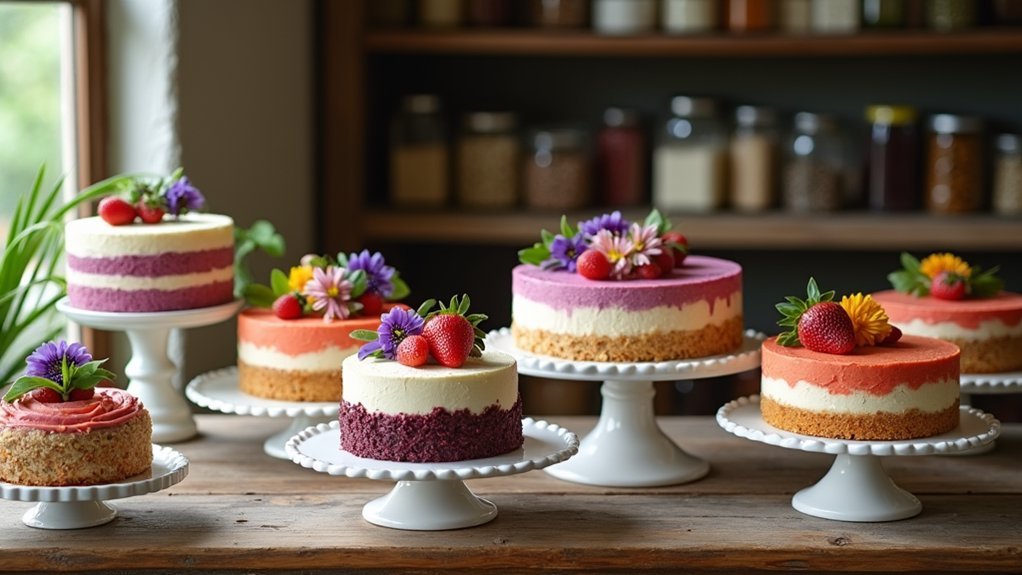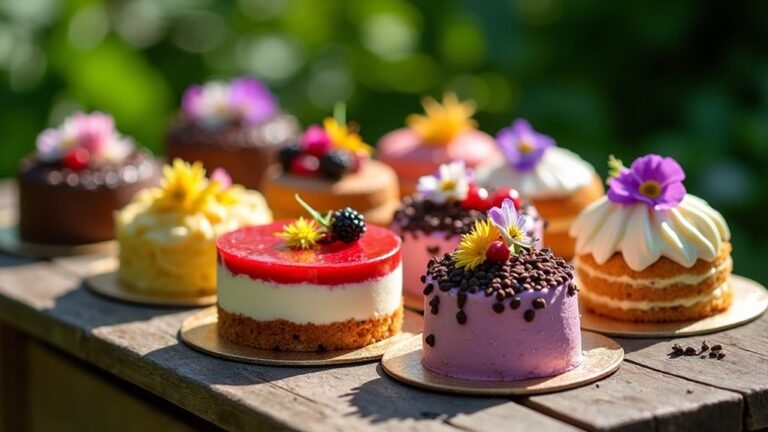The Ultimate Guide to Storing Organic Cakes
To store your organic cakes properly, place them in airtight containers at room temperature, away from sunlight and heat. For cakes with perishable ingredients, refrigerate them at temperatures between 0°C and 8°C, covering with a dairy product to help retain moisture. If you need to freeze your cakes, make sure they are completely cool, wrap them tightly, and label them clearly. Avoid cross-contamination with allergens. Each storage method helps maintain taste and quality, ensuring your cakes remain delicious. For dietary-specific cakes, look for additional techniques and tips to enhance your baking experience!
Key Takeaways
- Store organic cakes in airtight containers to keep them moist and flavourful, while also avoiding cross-contamination with allergens.
- Keep cakes at room temperature (10°-21°C) in a cool, dry place, away from direct sunlight and heat sources.
- For perishable cakes, refrigerate at 0°C to 8°C and cover with dairy or cream to prevent drying out.
- Freeze cakes for up to three months, wrapping them tightly in cling film and foil to prevent freezer burn.
- Clearly label all storage containers with dates and allergen information for easy tracking of freshness.
Understanding Organic Cake Composition
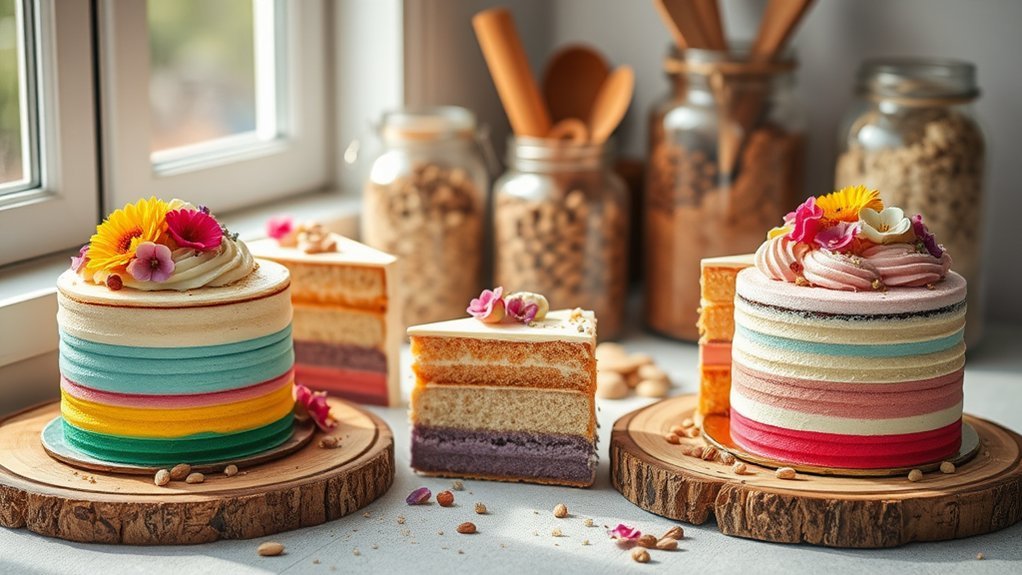
When you delve into the realm of organic cakes, you’ll find a wonderful mix of ingredients that enhance both flavour and health benefits. Organic all-purpose flour and cane sugar work together to create cakes with distinctive taste profiles. You can boost moisture with organic bananas or add crunch with walnuts. Organic ingredients ensure that your bakes are as wholesome as possible, further promoting health-conscious choices. Additionally, using sustainable farming practices in ingredient sourcing can contribute positively to the environment and local communities. Dietary options, such as gluten-free or vegan-friendly cakes, ensure that your bakes cater to a variety of needs. Alternatives like almond flour or dairy-free coconut milk provide even more ways to customise your cakes for any taste. By using the right ingredient ratios, you can strike a perfect balance between flavour and nutrition, impressing your guests while accommodating their health-conscious preferences.
Room Temperature Storage Best Practices
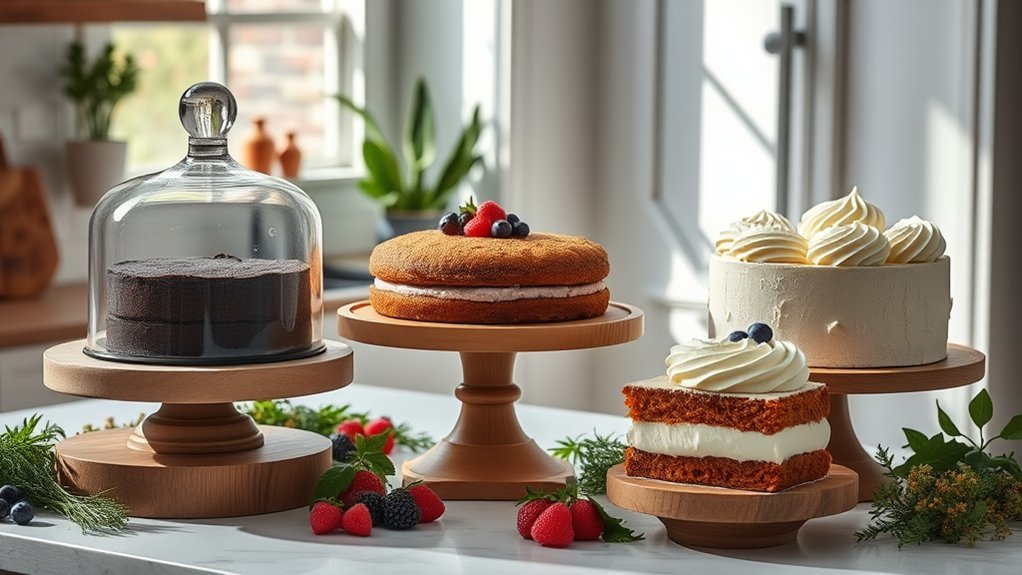
To keep your organic cakes fresh and tasty, it’s essential to store them properly. Use an airtight container to prevent moisture loss and preserve the rich flavours of your cake. Additionally, ensuring that your cake is stored at the appropriate temperature can significantly impact its shelf life. Organic cakes, with their higher levels of antioxidants, not only have a delicious taste but can also benefit from proper storage to maintain their nutritional value. A good environment can’t only extend your cake’s shelf life but also enhance its taste, so make sure to get these details right!
Ideal Storage Conditions
While refrigeration might seem like the best option for keeping cakes fresh, storing them at room temperature can actually preserve their flavour and texture better. For cakes without perishable fillings, a cool, dry environment helps maintain moisture and enhances taste. Aim to store your cakes in temperatures between 10°-21°C, away from direct sunlight and heat sources. Avoid refrigeration unless the cake contains perishable ingredients to prevent loss of moisture. Additionally, storing cakes made with organic ingredients can further enhance their rich flavor and quality. Controlling humidity is crucial, as high humidity can lead to sogginess or mould. Regularly check for spoilage, and ensure your cakes are organised to avoid cross-contamination with allergens.
Airtight Container Usage
Airtight containers are crucial for keeping your organic cakes fresh, ensuring they remain moist and tasty. They help retain moisture and protect against unwanted smells or pests.
When choosing a container, think about materials like glass, plastic, or ceramic—each has its perks. Opt for a size that fits your cake well, avoiding overcrowding.
Store your cake in a cool, dry spot, away from direct sunlight and strong chemicals. Check your cake regularly for freshness, ensuring the seal is intact to avoid spoilage.
Before use, clean and dry the container, and consider placing parchment paper between the cake and the lid. These simple steps will extend your cake’s shelf life and make serving a pleasure.
Flavor Enhancement Benefits
Storing your organic cakes at room temperature offers several flavour enhancement benefits that improve your baking experience.
By using effective flavour infusion techniques, you can maintain the cake’s intended taste, ensuring that every bite is enjoyable.
Here are the key benefits:
- Moisture Retention: Keeps your cake soft and prevents it from drying out.
- Flavour Preservation: Protects against unwanted odours, enhancing the overall taste.
- Texture Maintenance: Helps retain the original texture, stopping it from becoming stale.
Refrigeration Techniques for Perishable Ingredients
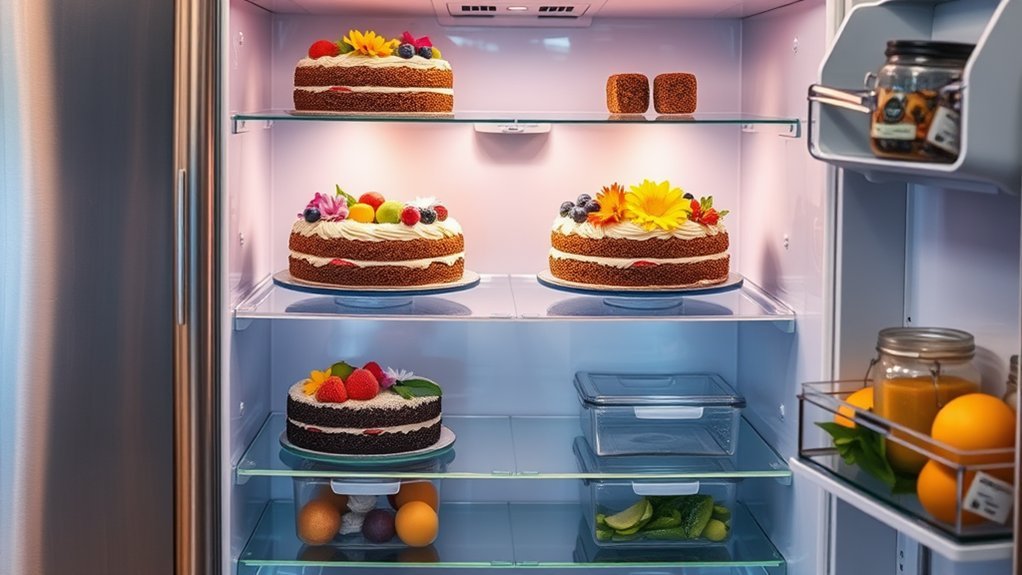
To ensure your organic cakes stay fresh and safe to eat, it’s vital to master refrigeration techniques for perishable ingredients.
Start by setting your fridge temperature between 0°C and 8°C. Store high-risk foods such as raw meat, dairy, and seafood at or below 4°C to limit bacterial growth.
Always cover your cakes, especially those containing dairy or cream, to prevent moisture loss and preserve flavour. Keep raw and prepared foods separate to avoid cross-contamination.
Regularly check your ingredients for spoilage, and make sure fruits and vegetables are stored correctly, removing leafy tops to extend freshness.
Effective Freezing Methods for Long-Term Storage
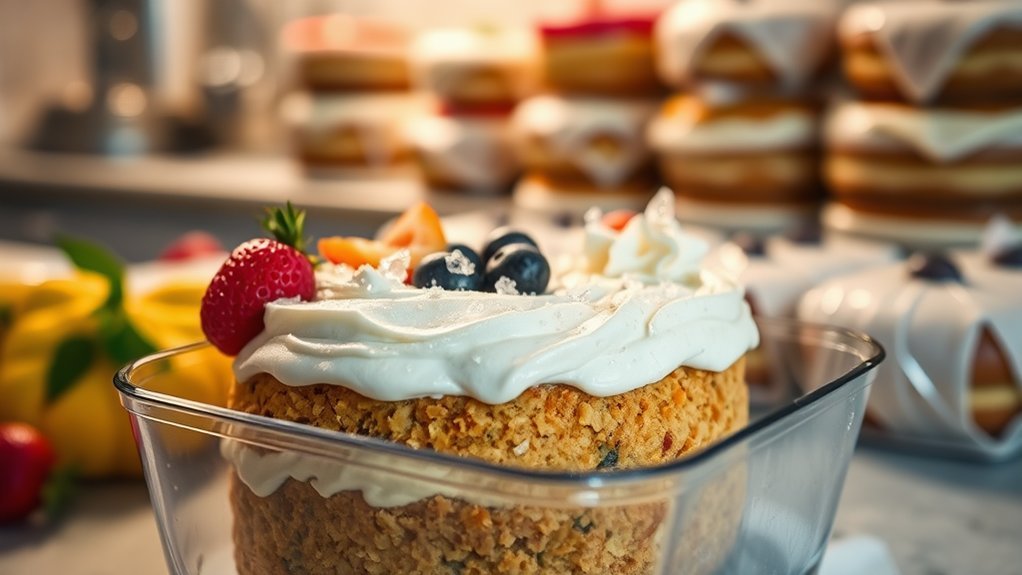
Freezing your organic cakes properly can significantly extend their shelf life while keeping their flavour and texture intact. Here’s how to do it right:
- Allow your cakes to cool completely before freezing.
- Carefully remove cake layers from their pans to avoid sticking.
- Wrap each layer tightly in plastic wrap and then in foil to prevent freezer burn.
- Store them in airtight containers or freezer bags for optimal preservation.
When it’s time to thaw, place the cake layers in the fridge overnight. This method helps retain moisture and quality.
Don’t forget to label your cakes with the date to keep track of freshness. By following these steps, your organic cakes will stay delicious and ready to impress your guests long after baking!
Specialized Storage for Dietary-Specific Cakes
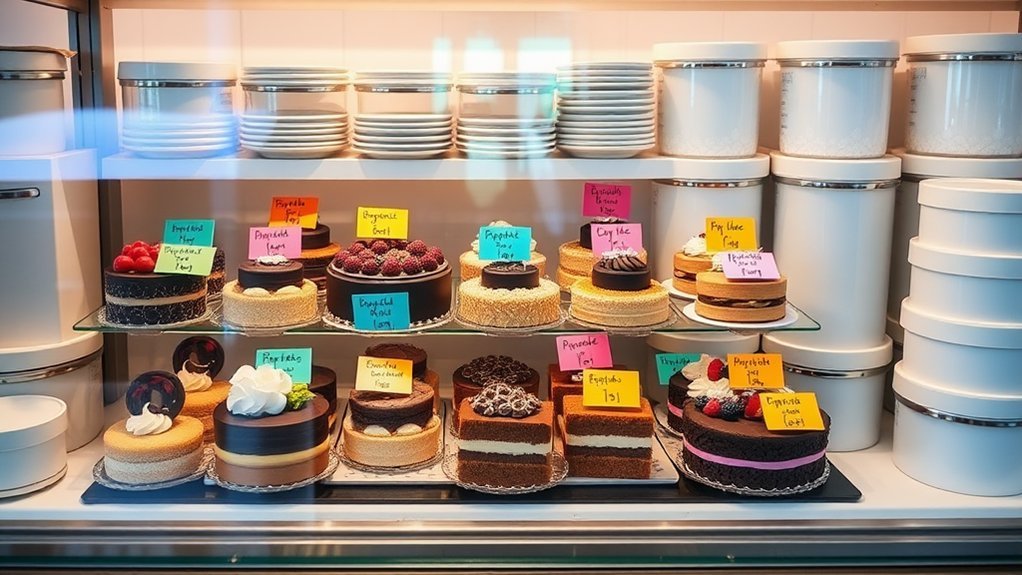
When storing dietary-specific cakes, it’s important to consider their individual needs.
Vegan cakes do best in cool, dry areas, whereas gluten-free cakes should be kept in airtight containers to maintain moisture and prevent cross-contamination.
For cakes that are free from allergens, it’s crucial to store them in clearly labelled, separate containers to ensure safety for those with nut allergies.
Vegan Cake Storage Tips
Storing vegan cakes may seem simple, but knowing how to care for these dairy-free treats is key to keeping their flavour and texture intact.
Here are some essential storage tips:
- Store cakes in a cool, dry place for up to five days.
- Use cling film or airtight containers to protect against moisture and air.
- If your cake has a perishable vegan frosting, it needs to be refrigerated.
When serving, cover cut edges with extra frosting or cling film to prevent them from drying out.
In humid conditions, ensure you keep your cakes in a dry space to maintain their freshness.
Enjoy sharing these delightful creations!
Gluten-Free Cake Preservation
To preserve the lovely texture and taste of gluten-free cakes, it’s important to tackle the unique storage challenges they present. Gluten-free cakes tend to dry out more quickly, which can affect their flavour and quality.
For short-term storage, keep them in an airtight container at room temperature for up to two days to maintain moisture. Avoid refrigeration unless the cake has perishable icing, as this can cause it to dry out.
If you’re freezing the cake, wrap it tightly in plastic wrap and then in aluminium foil, placing it in a freezer-safe container. For added moisture, you might try adding a slice of apple or bread to the container.
Allergen-Free Cake Guidelines
Storing allergen-free cakes requires careful attention to ensure their safety and quality, especially when accommodating dietary restrictions.
Follow these guidelines to keep allergen-free ingredients intact:
- Use airtight containers to prevent any flavour absorption.
- Clearly label cakes to indicate they’re allergen-free.
- Store in a cool, dry place, away from direct sunlight.
Be vigilant about preventing cross-contamination. Keep allergen-free cakes separate from potential allergens, using distinct, labelled containers for each type.
If your cake contains perishable ingredients, refrigerate it promptly. For longer storage, you can freeze cakes for up to three months.
This approach allows you to serve everyone confidently, prioritising their health and safety.
General Tips for Optimal Cake Preservation
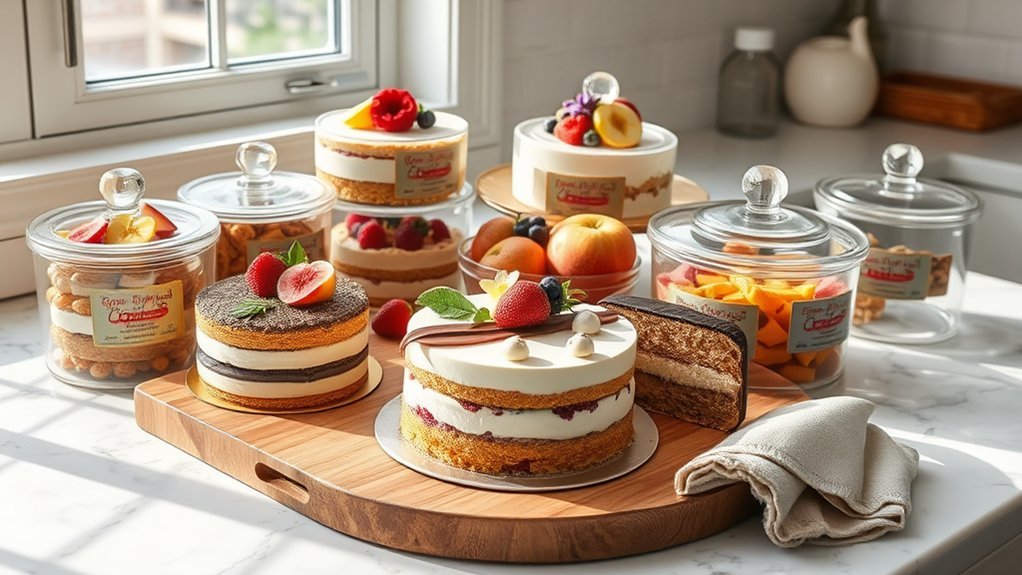
To keep your organic cakes fresh and tasty, follow these simple preservation tips.
First, allow your cake to cool completely to prevent moisture build-up. Remove any decorations to avoid spoilage, and consider adding a layer of frosting to exposed surfaces for better moisture retention.
Store your cake in an airtight container or wrap it tightly in cling film or foil to extend its shelf life. If your cake is cut, cover the edges with cling film or parchment paper.
Remember to refrigerate cakes containing dairy.
Finally, label your cakes with the date to keep track of their freshness.
These straightforward techniques will ensure every slice is a delightful treat for your guests!
Frequently Asked Questions
Can I Use Store-Bought Organic Frosting on My Cake?
Yes, you can use store-bought organic frosting on your cake! It’s a time-saver, comes in delicious flavours, and meets various dietary requirements while adding to your cake’s look and taste. Enjoy the convenience!
How Do I Know if My Cake Has Spoiled?
Consider your cake like a delicate flower; it wilts when it’s gone off. Look for signs of spoilage: mould, discolouration, unusual smells, and changes in texture. Trust your senses to identify these indicators before you serve it.
Is It Safe to Leave Cake Out Overnight?
Leaving cake out overnight isn’t always safe. If it has perishable ingredients, such as cream or fresh fruit, it’s best to cover it and pop it in the fridge. This helps prevent spoilage and keeps your cake tasty for when you’re ready to serve it.
Can I Mix Different Types of Organic Cakes in Storage?
Yes, you can mix different types of organic cakes, but it’s best to store them separately. This helps preserve their unique flavours and prevents them from blending together. For example, keep a rich chocolate cake in one container and a light lemon drizzle in another. Your guests will enjoy the distinct tastes in every slice!
What’S the Best Way to Decorate a Stored Cake?
To decorate a stored cake, focus on techniques like using a spatula for icing and consider natural decorations such as fresh fruit or edible flowers. These methods ensure a beautiful presentation that will impress your guests.
Conclusion
Mastering the art of storing organic cakes ensures your delicious creations retain their flavour and texture. For example, if you bake a rich vegan chocolate cake for a friend’s birthday, proper refrigeration can keep it fresh for up to a week, delighting taste buds long after it’s made. Whether you choose room temperature, refrigeration, or freezing, your careful storage decisions will keep your cakes irresistible and memorable!

